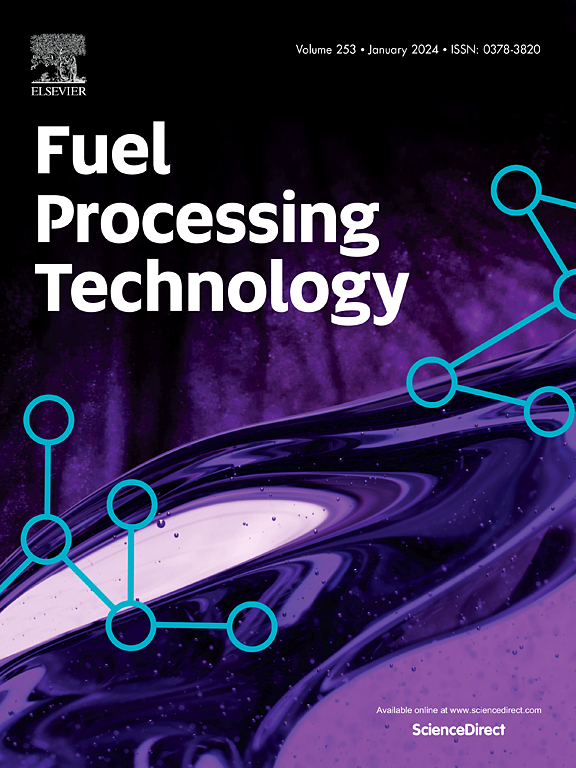Optimization of Ni loading amount in Ni-CeZrO2 catalyst for dodecane steam reforming for the upcycling of plastic pyrolysis oil
IF 7.2
2区 工程技术
Q1 CHEMISTRY, APPLIED
引用次数: 0
Abstract
In response to global efforts to address plastic pollution, pyrolysis of waste plastics offers a sustainable pathway for chemical recycling and clean hydrogen production. This study focuses on the steam reforming of dodecane, a key component of light oil derived from plastic pyrolysis, to produce hydrogen. Nickel-based catalysts supported on Ce0.8Zr0.2O2 (Ni-CeZrO2) with varying Ni loadings (1, 3, 5, and 10 wt%) were synthesized using a co-precipitation method and characterized by various characterization techniques. The catalytic performance was evaluated under steam reforming conditions at 750 °C. Among the prepared catalysts, 5 wt% Ni-CeZrO2 exhibited the highest hydrogen yield and dodecane conversion due to its optimal balance of Ni0 active sites, oxygen storage capacity, and strong metal-support interaction. The 10 wt% Ni-CeZrO2 catalyst showed higher initial activity but suffered rapid deactivation due to excessive carbon formation, while lower Ni loadings (1 and 3 wt%) showed insufficient active sites for effective reforming. The results indicate that 5 wt% Ni-CeZrO2 is the optimal loading amount for the steam reforming of dodecane, providing a balance between high activity and long-term stability.

塑料热解油十二烷蒸汽重整升循环Ni- cezro2催化剂中Ni负载量的优化
为响应全球应对塑料污染的努力,废塑料热解为化学回收和清洁制氢提供了一条可持续发展的途径。本研究的重点是十二烷的蒸汽转化制氢,十二烷是塑料热解产生的轻油的主要成分。采用共沉淀法合成了不同镍负载量(1、3、5 和 10 wt%)的 Ce0.8Zr0.2O2(Ni-CeZrO2)上支撑的镍基催化剂,并通过各种表征技术对其进行了表征。在 750 °C 的蒸汽转化条件下对催化性能进行了评估。在所制备的催化剂中,5 wt% Ni-CeZrO2 的氢气产率和十二烷转化率最高,这是因为它在 Ni0 活性位点、储氧能力和强金属-支撑相互作用之间达到了最佳平衡。10 wt% 的 Ni-CeZrO2 催化剂显示出较高的初始活性,但由于形成过多的碳而迅速失活,而较低的 Ni 负载(1 wt% 和 3 wt%)则显示出活性位点不足,无法进行有效的重整。结果表明,5 wt% 的 Ni-CeZrO2 是十二烷蒸汽转化的最佳负载量,可在高活性和长期稳定性之间取得平衡。
本文章由计算机程序翻译,如有差异,请以英文原文为准。
求助全文
约1分钟内获得全文
求助全文
来源期刊

Fuel Processing Technology
工程技术-工程:化工
CiteScore
13.20
自引率
9.30%
发文量
398
审稿时长
26 days
期刊介绍:
Fuel Processing Technology (FPT) deals with the scientific and technological aspects of converting fossil and renewable resources to clean fuels, value-added chemicals, fuel-related advanced carbon materials and by-products. In addition to the traditional non-nuclear fossil fuels, biomass and wastes, papers on the integration of renewables such as solar and wind energy and energy storage into the fuel processing processes, as well as papers on the production and conversion of non-carbon-containing fuels such as hydrogen and ammonia, are also welcome. While chemical conversion is emphasized, papers on advanced physical conversion processes are also considered for publication in FPT. Papers on the fundamental aspects of fuel structure and properties will also be considered.
 求助内容:
求助内容: 应助结果提醒方式:
应助结果提醒方式:


